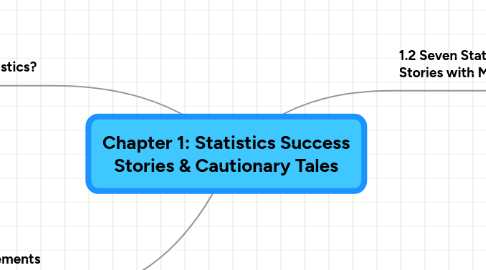
1. 1.1 What is Statistics?
1.1. Statistics: a branch of mathematics dealing with the collection, analysis, interpretation, and presentation of masses of numerical data
1.2. numbers measured for a reason
2. 1.3 The Common Elements in the Seven Stories
2.1. The Discovery of Knowledge
2.1.1. 1. Asking the right question(s)
2.1.2. 2. Collecting useful data, which includes deciding how much is needed.
2.1.3. 3. Summarizing and analyzing data, with the goal of answering the question(s)
2.1.4. 4. Making decisions and generalizations based on the observed data
2.1.5. 5. Turning the data and subsequent decisions into new knowledge
3. 1.2 Seven Statistical Stories with Morals
3.1. Case Study 1.1
3.1.1. Key Vocabulary
3.1.1.1. Data: information in numerical form that can be digitally transmitted or processed
3.1.1.2. Median: when numbers are ordered lowest to highest, the center number. (or average of two center numbers if there are two)
3.1.1.3. Lower quartile: the median of the lowest number to the overall median
3.1.1.4. Upper quartile: the median of the overall medium to the highest number
3.1.2. Point of Case Study
3.1.2.1. When graphed or organized statistical can be easier to understand and may show similar patterns
3.2. Case Study 1.2
3.2.1. Key Vocabulary
3.2.1.1. Rate: number of times it occurs per number of opportunities for it to occur.
3.2.1.2. Risk: can be estimated by using the past rate for that outcome.
3.2.1.3. Base rate or Baseline risk: rate or risk at the beginning of a period or under specific conditions.
3.2.2. Point of Case Study
3.2.2.1. To show the difference between rate and risk. Also, to emphasize to include tne base rate and baseline risk to accurately compare results
3.3. Case Study 1.3
3.3.1. Key Vocabulary
3.3.1.1. population: all of the individuals or subjects from which information is sought of
3.3.1.2. Random sample: representatives of a population chosen with the same probability of being chosen as anyone else in the population
3.3.2. Point of Case Study
3.3.2.1. A small random sample can represent a large population
3.4. Case Study 1.4
3.4.1. Key Vocabulary
3.4.1.1. Nonresponse bias:When people selected for a sample don't respond. Yielding data only from those who did respond who may feel strongly about the subject. Getting data only from those motivated by the topic and a true sample of the population.
3.4.1.2. Self-selected sample or volunteer sample: a sample that tells you nothing about a general population but only about those who are willing to respond
3.4.2. Point of Case Study
3.4.2.1. A sample of people who do not truly represent the overall population you're trying to study can't be used to represent the general population.
3.5. Case Study 1.5
3.5.1. Key Vocabulary
3.5.1.1. Observational study: participants are observed and measured
3.5.1.2. Variable: a characteristic that is different between subjects
3.5.1.3. Confounding variable: a variable that may be responsible for results but not the main concern of the study
3.5.2. Point of Case Study
3.5.2.1. correlation is not causation
3.6. Case Study 1.6
3.6.1. Key Vocabulary
3.6.1.1. Randomized experiment: participants are randomly assigned treatment
3.6.1.2. Treatment: a specific procedure assigned to the participants by the experimenter
3.6.1.3. Random assignment: when all participants have the same probability of receiving the true treatment or the placebo
3.6.1.4. Placebo: a treatment that looks identical to the actual treatment but doesn't affect the subject.
3.6.1.5. Statistically significant: relationship or difference is one that is big enough to be unlikely to occurred in the sample if there was no relationship or difference in the population
3.6.2. Point of Case Study
3.6.2.1. Randomized experiments are a good means to come to a conclusion on a cause-effect study.
3.7. Case Study 1.7
3.7.1. Point of Case Study
3.7.1.1. correlation is not causation
3.7.1.2. Find out the magnitude of a studies results
